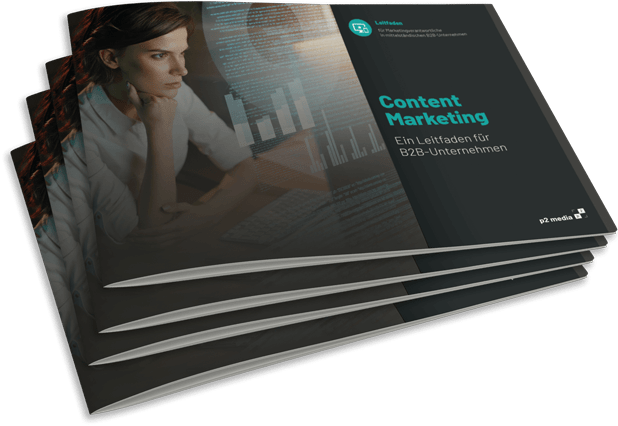Doing B2B marketing on the web offers you a lot of clear advantages: Since today practically every (potential) customer, when becoming aware of a challenge or a need - be it in the private or business environment - first looks for applicable solutions via one of the major search engines or social networks, the range of corresponding marketing activities is usually very large. You can carry out this extremely targeted and, among other things, highly efficient through marketing automation. The entry via SEO optimization and the associated increase in customer visits to your own company website is the basis for today's B2B online marketing.
A particular advantage is that all SEO marketing measures can be measured on a small scale using KPIs, which enables appropriate optimization. In fact, a continuous sequence of analyses, data evaluations and further developments is absolutely decisive for today's competition. On the one hand, this is the only way to find out whether your efforts are really effective or economical, and on the other hand, the requirements and expectations of your (potential) customers are changing slowly but constantly. The latter now act very self-determined on the web or see their interests there absolutely in the center.
Lead management, i.e. - to put it simply - all the efforts involved in obtaining customer contact data and processing it in a way that is beneficial to your own company, is one of the most relevant marketing instruments, especially in the B2B sector. Because here it is possible to consider the concerns of (potential) customers, which are important for marketing, not only incomparably precisely, but also on a relatively personal level. Both can be very helpful to your business, especially since B2B products often require more explanation and/or involve comparatively large investments, and (potential) customers consequently prefer providers with such differentiated support. Like all marketing measures, lead management should also be constantly monitored and further developed - and B2B conversion rate optimization plays a very central role in this.
What is the conversion rate and its optimization?
The conversion rate is a key figure in percent, which shows the relationship between the number of website visitors of your company and the target actions completed by them. The latter usually mark a change of status of (potential) customers - for example, from prospect to lead, from lead to qualified lead or from lead to buyer. Basically, such changes of status are conversions in themselves - but the term is generally used synonymously with the target actions leading to them. A company always defines these target actions or conversions itself. In practice, the marketing process and the subsequent sales process are made up of a chain of conversions, each of which can and must be measured. In this chain, errors can certainly occur. If one link is left out, the entire result will not be satisfactory. To avoid this, B2B conversion optimization should be practiced. In terms of the conversion examples above, the term "B2B conversion optimization" describes increasing the percentage of conversion of visitors to the company's landing page to leads or to customers - lead nurturing, so to speak. In the context of lead management, it is more specifically about evolving the process by which company website visitors become leads, converting them from leads to Marketing Qualified Leads (MQL's), from MQL's to Sales Qualified Leads (SQL's), and from SQL's to customers. We will provide you with such an example/typical sequence with concrete numbers in more detail below.
What does B2B conversion rate optimization mean for the
lead management process?
Put simply, the conversion rate says something about the quality of your lead management - how well it works. It clearly shows you where there is a need for optimization for better findability in the search engines or the touchpoints of the customer journey, such as "call to action" on the landing page, etc. The conversion rate is the key to success. If there is a drop-off at any point of the sales funnel, it is important to optimize the conversion rate there. Particularly in lead management, which operates on a very small scale, consideration and adjustment is essential. The conversion of a single visitor shows you in which situation this visitor is, from which you conclude in marketing or ultimately in sales how you should deal with this visitor. If this visitor downloads a whitepaper on a landing page and gives his email address in return, then the page has obviously convinced him. The conversion rate of this page now lets you know how high the percentage of visitors is who find your landing page so good that they move from prospect status to lead status. The success of the company's landing page and your lead management is therefore very meaningful to measure and develop accordingly.
With the conversion rate, however, you can not only analyse the lead performance of your website or specific landing pages and carry out a corresponding lead increase, but also every single other marketing channel - including the e-mail dispatch, which is always central in lead management, or its acceptance by your leads. All in all, it's not just the individual values that count, but in particular the development of the conversion rate over time. This will tell you, among other things, whether interest in one of your topics or content types is waning, or give you indications that your competitors may now be offering better content.
What role do KPIs play in lead management?
KPIs are key performance indicators with which you can track the activities in your company and make them tangible in figures. These key figures are not only relevant in online marketing, but can be recorded particularly easily and processed very expediently. Every discipline has its own very important KPI's and even from industry to industry there are differences in the relevance of the figures to be considered.
Only through consistent monitoring by KPI's can successes and failures of marketing processes be recognized and optimized. The best way to follow the development is along the sales funnel. Starting with the prospect's search for information all the way to the conclusion of the sale, countless numbers accumulate at every stage of this funnel. Staying on top of this data jungle can be very difficult. Therefore, it is recommended not to look at too many KPI's to get started. The conversion rate is already very meaningful on its own and should therefore always be taken into account. However, it is even more useful if you combine it with other KPIs, such as the sales cycle, cost-per-lead and/or cost-per-order. Conversion rate is the central KPI for any lead management strategy. It is essential at various points in the sales funnel. If a conversion occurs here, it means that a previously defined goal has been achieved. This can be the download of content via a landing page, but also the click on a call-to-action in a lead nurturing email. For you, capturing such data is just as significant as knowing what revenue you ultimately make with your lead management. Because one value conditions the other, and the conversion rate reveals what efforts are needed to drive success. In short, conversion rate is an extremely important KPI for future marketing planning. Among other things, it gives you an indication of what needs to be done in general to optimize advertising budget allocation. With its help, every single stage in the sales funnels can be precisely analyzed. It answers important questions such as: How many leads did the double opt-in, signaling that the gated content was compelling, how many leads became qualified leads, what content was particularly helpful in achieving that, and how can it be profitably used in other marketing as well as advertising areas? The possibilities for conclusions are enormous.
What is the typical conversion rate path in the sales funnel and what needs to be done to smooth it out?
As previously mentioned, the best way to see the composition of the chain of conversions in lead management is to look at your sales funnel. This typically starts with visitors, narrows to leads acquired, then on to Marketing Qualified Leads (MQL's) as well as Sales Qualified Leads (SQL's) and at the end there are customers.
A mid-sized B2B company that wants to close 5 new customers per month must first ensure the right number of visitors to their own company website. If good content is provided, this can be used to get an average of around 2 percent of visitors to fill out or submit a form. Thus, it is possible to generate around 200 leads with a visitor volume of 2,000 users. Experience shows that about 30 percent of these leads are also MQL's. These leads fulfil the basic requirements to become customers. Contact should be made with them. In the course of this, they are further qualified in order to finally find out whether there is an immediate purchase intention. Here, a rate of 25 percent is already very good. Finally, it is the sales department's turn, which at best achieves a closing rate of between 30 and 50 percent. To achieve these good to very good values, you should consider the following optimization approaches:
Address your target group with value-added content on your B2B website or specific landing pages. This is the basic prerequisite for a good conversion rate in the top section of the B2B sales funnel. Optimizing your content marketing strategy is therefore extremely important.
This also applies to exclusive downloadable content. Optimally, these act as lead magnets that encourage your visitors to submit their data. In combination with a strategically clever call-to-action, you have very good prerequisites for a significant lead increase. Make your content and likewise gated content for download significantly eye-catching, useful as well as irresistible.
With the quality of your content, you decide not only how many leads you receive, but also whether they are marketing qualified leads, i.e. those that are worth further processing. Whether a lead has the potential to become a customer, you will ultimately find out through manual research and lead scoring. The latter is most efficiently done using a marketing automation solution that collects contextual information about your contacts and categorizes them.
Furthermore, it is imperative that you provide these contacts with exactly the content they need at the respective point in their customer journey or according to their lead status. A (potential) customer who is at the very beginning of the buying process and who is also a fresh lead will of course need completely different information than someone who has already been dealing with goods or services that you sell for a longer period of time in general and has perhaps even already bought from you.
Within B2B Lead Nurturing, you edit your MQL's until they eventually become SQL's. This usually takes some time. Because leads in the B2B area are in the so-called decision phase for a comparatively long time. The best way to accelerate this phase is to provide content that speaks for your goods or services. Of course, this should not be a flat advertisement, but rather make it clear to your leads that you or your brand understand their challenges or needs and that they are therefore in the best hands with you. This is another place where marketing automation can be of great use to you. Such solutions identify individual needs and play out the right content with pinpoint accuracy.
In order to convert MQL's into SQL's, it can already make sense in some contexts to establish direct/personal contact with your (potential) customers. The "how" of contacting them is quite crucial here. Remember that these leads are not yet sales-qualified. Therefore, it is also important to proceed very sensitively and differentiated here.
The transition between B2B marketing and sales that often takes place or needs to be initiated at this point, or the correct handover of leads between departments, is often difficult. It is not uncommon for the conversion chain to break down here. Marketing decides which leads meet SQL's criteria and then hands them off to sales. The clear definition and process of the handover must be defined in detail. The problem here is that in many B2B companies, marketing and sales still do not work together sufficiently closely. This should be remedied at the grassroots level through a common interface in the form of a customer relationship management (CRM) program and, if necessary, a service level agreement (SLA). In the latter, Marketing promises Sales to deliver a certain number of leads each month. Accordingly, the promise comes from sales to process these leads within a certain time.
In today's B2B marketing, sales also needs specific content to effectively process leads. The task of marketing here is to provide suitable content but also lead data and to support sales.
Furthermore, sales should definitely rely on technical helpers in order to efficiently keep the conversion rate high. A good CRM is generally indispensable here. At best, this combines communication, social media, data, document and content management tools and other useful tools and generally makes your B2B sales much more powerful.
Furthermore, sufficient sales training or ongoing education of all marketing and sales staff is advisable. In today's predominantly digital business environment, it is important to keep an eye on the constantly changing methodological, technical and customer-specific requirements in order to achieve maximum success.
Our support around the topic of lead management:
The generation of high-quality leads forms a significant key factor for long-term business success in B2B and B2C marketing.
- We develop and implement successful lead generation concepts to make the most of your potential and create the right conditions for efficient and personalised marketing measures.
- We support you in first defining and analysing your optimal target groups and then using relevant content to reach them exactly where they are digitally.
- Together with you, we develop a practicalnurturing process to generate qualitative leads along the entire customer journey.
If desired, we will be happy to implement amarketing automation solution that complies with data protection regulations - support in both the selection of the right software and the implementation and monitoring of your campaigns.
Oliver Parrizas will be happy to answer any questions you may have on the subject. +49-800-911-91-91











